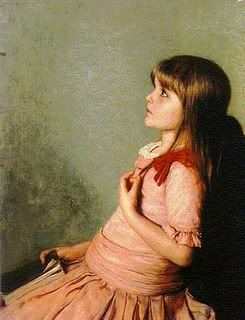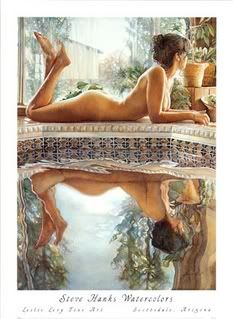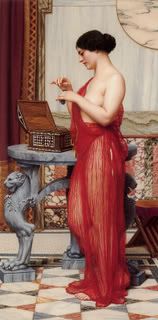
After a hopefully in depth exploration of richer and heavier jasmine fragrances, it's time to concentrate on some that are airier and more transparent, fit for those days when fragrancing oneself should seem like a breeze and not a serious seduction mission. They also lend themselves well to hot climates and soaring temperatures, if you happen to live in those conditions take note. Very often hedione or cis-jasmone (which has an almost anise or liquorice smell by itself) is used to render the illusion of smelling a live jasmine vine.
In this exploration Blush by Marc Jacobs is the first to come in mind, like a gauze of light salmon/peach , reflecting the skin like tones of the opalescent bottle and evoking a similar mood. The reality of the flower is synthesized in a lab, but the result is akin to smelling the vine from a distance on a warm evening with a citrusy top note like that from a nearby citrus tree. It has a dewiness (frankly much better than that in Jacob's eponymous scent centered on gardenia) and a translucence that usually lends itself to an instant likeability by lots of people and it can be worn on many occassions effortlessly. Of course the development is not the mercurial beast one would hope for, rather it progresses linearly, as we say in perfume-speak; meaning it does not change much on its stay on the skin ending on the predictable white musks of most commercial perfumery offerings. In the Intense version the flower elements have been amplified and the sillage/trail left behind is more intense, however I find that some of the loveliness of the original is lost, like watercolours of a painting of a flower bouquet that is copied in pastels; somehow the airiness is forever gone.
Another fresh soliflore jasmine is Annick Goutal Le Jasmin. The Goutal line of scents has a rich lineage in fragrances that smell fresh, true, crystalline and transparent in the best possible sense. They project a youthful approach even when they are more mature smelling and they are based on good ingredients that are steeped in the natural cornucopia of aromas. In that vein, the brand under the proficient baguette of Isabelle Doyen has produced a range of limited edition soliflores, based on the most precious and loveliest blossoms imaginable: Des Lys (lilies), La Violette, Le Cheuvrefeuille (honeysuckle), Le Jasmin, Le Muguet(lily of the valley) and the latest - this year's Néroli. They all merit their own space and we will return to them on subsequent series, however Le Jasmin is highlighted today because of its green tonality and sheer prettiness that makes for a very worthy acquisition in the pantheon of soliflore jasmines. The addition of waxy magnolia petals is an inspired choice along with a slightly spicy note that official info tells us it's ginger. I do not have an affinity for strong ginger notes in perfumes, so this is rather subdued to my nose, because I do like the effect quite a bit. The main drawback is that it being an eau de toilette and a light fragrance by nature, it somehow falls a little flat pretty soon and the lasting power is not the greatest. Since it is so lovable however I could imagine it being refreshed all day long with no problems.
Another crowd pleaser seems to be Pink Jasmine by Fresh. Well, Fresh their brand name is and "fresh" aromas is what they usually produce. To be totally honest I haven't been too impressed with their line in the past, apart from the very likable apothecary bottles with the cute "handwritten" style labels and the long necks with the matte silver sprayer. From their lineup I had liked the watery ambiance of Cucumber Baie (an unlikely combination that nevertheless managed to smell nice), Violet Moss with its earthy dusty smell and their Patchouli Pure which was cuddly and deep. Their Sugar versions (Sugar, Lemon Sugar, Sugar Blossom, Lychee Sugar) were too sweet and lamentably artificial to my nose; so my exploration of the line pretty much ended with last year's rather unique Memoirs of a Geisha which was nice but not enough attention-grabbing for me.
Pink Jasmine is quite new and it takes a soft approach that is not too sweet managing to inject a clean and shower fresh element with peony and magnolia bowls of petals; despite the initial impression upon first spray ~which might fool you into a false sense of an intense citrusy sharp floral. It lasts well with an aqueous impression similar to En Passant, but perhaps it is a little pricey for what you ultimately get.
For Sylvia Chantecaille, there are two roads she could go by and she chose the less travelled by...or perhaps not. Actually she chose both in a way. The heavier, more tropical one with her Frangipane and the lighter, airier with Le Jasmin by Chantecaille. Since today we're concentrating on the more crystal-like florals centered on jasmine, it seems a propos to discuss the latter's merits and shortcomings.
To its advantage it has a refreshing lightness and greenery freshness aplenty which can never be blamed for producing a headache; the inclusion of other floral notes, notably a little bit of tuberose are subdued enough to not project over the jasmine solo. However there is a touch of lily-like artificiality (which regrettably seems inherent in the lighter end of the jasmine spectrum, due to the very nature of the production methods) and the lasting power as it exits on a slight oakmoss and amber note is not tremendously satisfying either, which is a pity for the price.

In the noble stable of Bulgari only thoroughbreds are kept, so it made an impression on me that one of the versions of their venerable Bulgari pour femme, namely Voile de Jasmin fell short of my expectations that had been raised by their other version Rose Essentielle ; which has been excellent. Alas, Voile de Jasmin does not make any ripples in the pond of jasmine scents and it doesn't particularly smell of jasmine petals either. It just makes the initial composition of Pour Femme a little more soapy clean and lighter which is not really what I call progress. Stick to their Rose essentielle version if you really want your Bulgari fragrance floral.
Miller Harris came out with Jasmine Vert for her private exclusive line in her London boutique and I have to say that her translucent compositions usually use good ingredients that smell true. This is no exception and although there has to be some chemical tampering with the notes, the result is not at all artificial. The freshness is real, tangible and quite alluring like in her Fleur du Matin fragrance which marries honeysuckle to champagne-like citrusy notes for a refreshing day fragrance similar to the feeling of Cristalle. In the fragrance at hand, Jasmin Vert , if we are to continue the Chanel parable, it is greener in the vein of Chanel no.19 or Gardenia (constructed around jasmine despite the name), albeit very short on the complexity and depth, especially compared to those of the former.
However for a warm summer day when you want to let your hair down and just revel in the brightness of it all it is appropriately fitting.
L'artisan Parfumeur is famous for the limpid, light, diaphanous composition of their scents and alongside their heavier, intense La Haie Fleuri they have also produced the lovelingly ethereal Thé pour un été (=tea for summer). As its name suggests it's based on jasmine tea more than jasmine petals themselves the way florals are and along with lemony overtones it forms a decaffeinated sipping brew that can be likened to Bulgari's Eau Parfumée or a fresh Eau Sauvage that can also be worn by both sexes. Light, fleeting and not so ephemeral any more -as the brand decided to include it in their mainstay line after a stint as a limited summer edition following its success at the counter- it is meant to be used with abandon, chilled in the fridge for the hot days of summer ahead. Indulge!
OTHER HONOURABLE MENTIONS:
Due to lack of space or inability to categorise them in a specific pigeon-hole the following scents are simply mentioned as noteworthy along a jasminophile's expedition in the pursuit of jasmine-rich fragrances.
Those include the clear cut Jasmal by Creed, the simultaneously fresh and animalic paradox Night blooming Jasmine by Floris, the misnomer that is Chanel Gardenia, the happiness of youth that is represented in the tuberosy La chasse aux papillons(=chassing butterflies) by L'artisan (in the Eau de toilette concentration), the worthy limited edition of Givenchy Millesime Harvest Jasmine of India 2005 and the new exclusive by Armani éclat de Jasmin.
Perhaps a subsequent visit to all of those is in order, of which you will be notified in due course. For the time being our jasmine pilgrimage ends here. Hope you enjoyed it as much as I did.
Artwork:
Top "Girl" by greek painter Nicolaos Gyzis courtesy of Wikipedia and bottom "Reflecting" by Steve Hanks courtesy of allposters.com
.jpg)









.jpg)

.jpg)
